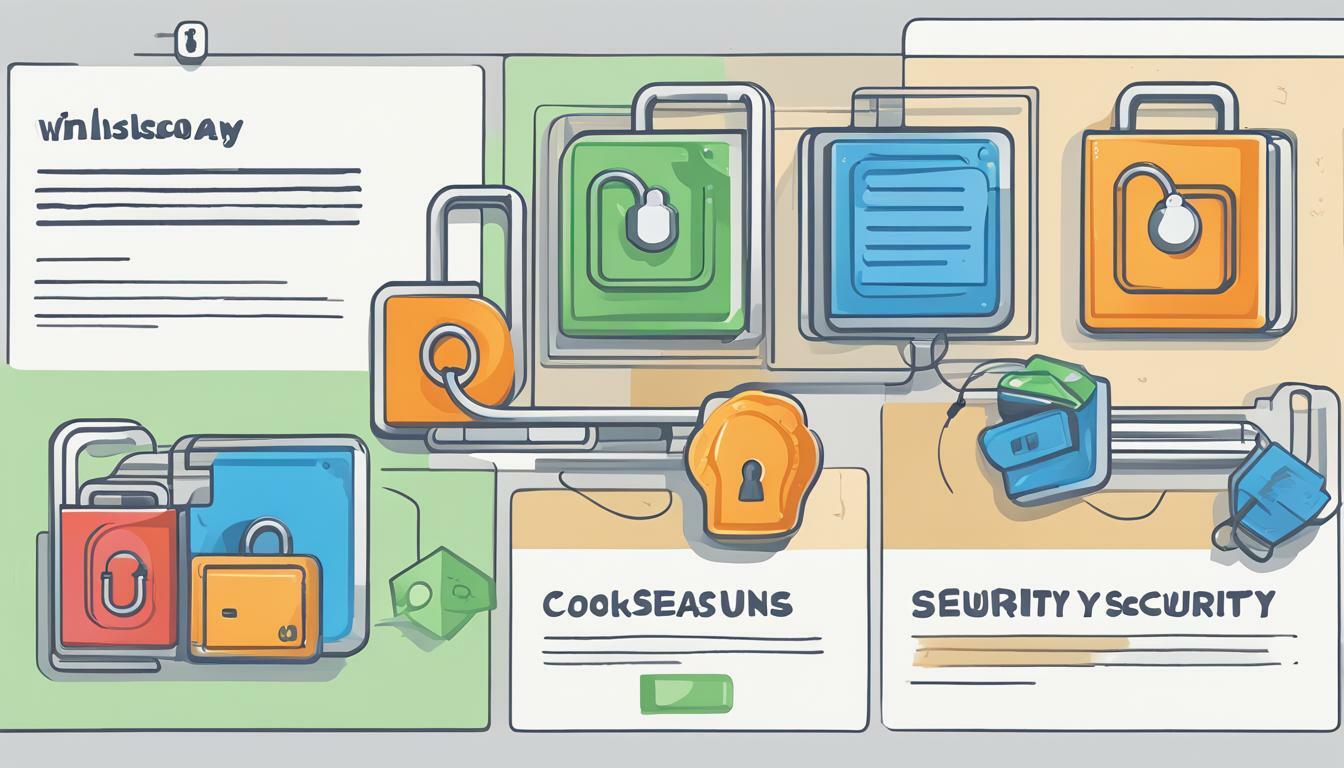
In today’s digital age, web authentication plays a crucial role in securing websites and user data from potential threats. Tokens, cookies, and sessions are the three building blocks of web authentication, each serving a unique purpose in ensuring the security of web applications.
Tokens are used for authentication purposes, while cookies and sessions help maintain user state during a session. To ensure the robustness of web authentication mechanisms, it is essential to have a clear understanding of how these building blocks work together.
Key Takeaways:
- Tokens, cookies, and sessions are the three building blocks of web authentication.
- Tokens are used for authentication, while cookies and sessions maintain user state during a session.
- Understanding these building blocks and implementing robust security measures is crucial for web application security.
The Role of Tokens in Web Authentication
In web authentication, tokens play a crucial role in securely identifying and verifying users. Authentication tokens are essentially random strings of characters that are issued by the server to the client (usually a web browser) upon successful login.
Token-based authentication involves using these tokens to authenticate users on subsequent requests. When a user logs in, the server generates a token and sends it to the client, which stores it locally (usually in a cookie or local storage). On subsequent requests, the client sends the token to the server alongside the request. The server verifies the token’s authenticity and, if valid, allows the requested action.
Authentication tokens have several advantages over other authentication methods, such as passwords. One key advantage is that they are typically short-lived and expire after a certain period. This means that even if a token is stolen, it will not be valid for long, reducing the chances of it being used for malicious purposes.
Another advantage of token-based authentication is that it allows for statelessness on the server side. Since the server does not need to keep track of user sessions (as with session-based authentication), it can be scaled more easily and is less prone to performance issues.
In summary, tokens are a key component of web authentication, providing a secure and scalable method for verifying user identities. Token-based authentication is a popular approach due to its many advantages, including short-lived tokens and statelessness on the server side.
Understanding Cookies in Web Authentication
When it comes to web authentication, cookies play a crucial role in identifying and authenticating users. A cookie is a small piece of data that is sent from a website and stored on the user’s browser. It is commonly used to store user preferences, login credentials, and other relevant information that can be used to enhance the user experience.
Cookie-based authentication is one of the most widely used methods for web authentication. When a user logs in to a website, the server creates a unique session ID for the user and sends it to the browser in the form of a cookie. This cookie is then sent back to the server with each subsequent request, allowing the server to authenticate the user and maintain user state throughout the session.
However, cookies come with certain security risks. Cookies can be intercepted by attackers, who can then use them to gain unauthorized access to a user’s account. This is known as session hijacking. To mitigate this risk, websites should implement secure cookie management techniques, such as encrypting cookies, setting secure flags, and implementing cookie expiration policies.
Despite the potential security risks, cookies are still widely used in web authentication. They provide a convenient and efficient way to authenticate users and maintain user state during a session. However, it is important for website owners to implement proper security measures to prevent the unauthorized access to user data.
Exploring Sessions in Web Authentication
Sessions are an essential component of web authentication, allowing web applications to maintain user state during a session. A session is a period of interaction between a user and a web application, typically starting when the user logs in and ending when the user logs out or the session expires. Sessions enable web applications to remember the user’s identity and keep track of their preferences, actions, and data.
Session-based authentication involves the use of sessions to authenticate users. When a user logs in, the server creates a new session and assigns a unique session ID to it. The session ID is then used to identify the session in subsequent requests from the user. The server stores the session ID on the client-side, typically in a cookie, so that the browser can send it back to the server with each subsequent request.
Session management is the process of handling sessions securely and efficiently. To ensure the security of web applications, session management techniques must protect against session hijacking and session fixation attacks. Session hijacking, also known as session stealing, occurs when an attacker takes over a user’s session by stealing their session ID. Session fixation involves an attacker forcing a user’s browser to use a predetermined session ID, allowing the attacker to control the session.
To prevent session hijacking and session fixation, session management can implement various measures, such as:
- Session timeouts: Sessions should expire after a period of inactivity or after a specified time, forcing the user to log in again.
- Secure session IDs: Session IDs should be long, random, and unpredictable, making it difficult for attackers to guess or discover them.
- HTTPS: Transport Layer Security (TLS) should be used to encrypt the communication between the client and the server, preventing eavesdropping and man-in-the-middle attacks.
By implementing session-based authentication and session management techniques, web applications can provide a secure and seamless user experience, while protecting user data and privacy.
Comparing Token-Based and Cookie-Based Authentication
Token-based authentication and cookie-based authentication are two common approaches used by web developers to secure web applications. Both methods have their advantages and disadvantages, and the choice depends on the specific requirements of the application. Below we will compare the two approaches and highlight some of the key differences.
Token-Based Authentication
Token-based authentication involves the use of authentication tokens, which are generated by the server and sent to the client after successful authentication. The client then sends the token with each subsequent request to the server to authenticate the user. Tokens can be stored in local storage or session storage, which makes it easy to implement stateless authentication.
One of the advantages of token-based authentication is that it is not vulnerable to cross-site request forgery (CSRF) attacks since the token is not sent with each request, unlike cookies. Tokens also offer better control over user sessions, as they can be easily revoked or expired, making it more secure.
Cookie-Based Authentication
Cookie-based authentication involves the use of web cookies to store user authentication data on the client’s machine. When a user logs in to a website, a cookie is sent to the server containing the authentication data. The server then validates the cookie with each subsequent request to authenticate the user.
One of the advantages of cookie-based authentication is that it is easy to implement and does not require additional server-side storage, unlike token-based authentication. However, this approach is vulnerable to CSRF attacks since cookies are sent with every request, and any attacker can steal them. Also, cookies can be easily manipulated, making it less secure.
Considerations When Choosing Between Token-Based and Cookie-Based Authentication
When choosing between token-based and cookie-based authentication, some considerations to keep in mind include the application’s security requirements, the type of data being transmitted, and the user experience. If security is a top priority, token-based authentication may be the better option, as it offers more control over authentication and better protection against CSRF attacks. For applications where quick and easy implementation is more critical, cookie-based authentication may be more appropriate.
In conclusion, both token-based and cookie-based authentication have their pros and cons. It is up to the developer to choose the appropriate method based on the application’s specific requirements and security considerations. By keeping these considerations in mind, developers can implement robust authentication mechanisms that provide the best possible user experience while protecting sensitive data from security threats.
The Importance of Web Security in Authentication
Web security is a critical aspect of authentication systems. Without robust security measures, user data is vulnerable to various security threats, such as session hijacking and cross-site scripting attacks. Therefore, it is crucial to implement effective security measures to ensure that user data remains protected.
Authentication tokens, web cookies, and session authentication are all vulnerable to security breaches. Token-based authentication can be compromised if the token is intercepted or stolen. Web cookies can be vulnerable to cross-site scripting attacks, allowing attackers to hijack user sessions. Session authentication can be compromised if session IDs are not adequately protected.
To prevent security breaches, it is essential to implement suitable security measures. For example, using secure protocols such as HTTPS can help protect user data from interception. Additionally, token authentication systems should use secure token storage and token expiration policies to prevent token theft and misuse. Cookie authentication systems should implement secure cookie storage and cookie security measures like HttpOnly and Secure flags to prevent cross-site scripting attacks. Implementing suitable session management techniques like session timeouts and secure session IDs can also help prevent unauthorized access to user data.
In conclusion, web security is critical for secure web authentication. The use of robust security measures can help prevent security breaches and ensure that user data remains protected. By implementing best practices for web authentication, organizations can create a secure environment for users to access web applications and services.
Best Practices for Implementing Web Authentication
Implementing web authentication is critical for securing web applications and protecting user data. Whether you’re using token authentication, cookie authentication, or session authentication, it’s important to follow best practices to ensure a robust and secure authentication system. Here are some key considerations:
Secure Token Storage: Store tokens securely to prevent unauthorized access or theft. Use industry-standard encryption algorithms and avoid storing tokens in plain text. Consider using a separate database or server for storing tokens.
Token Expiration: Set an expiration time for tokens to limit their lifespan and reduce the risk of exploitation. Refresh tokens periodically and invalidate tokens that are no longer needed. Consider implementing token revocation mechanisms for additional security.
Cookie Security Measures: Use HTTP-only cookies to prevent cross-site-scripting attacks. Set the secure flag to ensure that cookies are only transmitted over HTTPS connections. Consider using the same-site attribute to prevent CSRF attacks.
Session Timeout: Establish session timeouts to limit the duration of user sessions. Implement mechanisms for detecting idle sessions and automatically logging users out after a predefined period of inactivity.
Use Secure Protocols: Use secure communication protocols, such as HTTPS, to protect sensitive data transmitted over the network. Implement mechanisms for detecting and preventing man-in-the-middle attacks.
Following these best practices can go a long way in ensuring the security and integrity of your web authentication system. Regularly updating authentication mechanisms and keeping up-to-date with the latest threats and vulnerabilities is also crucial in maintaining a strong defense against attacks.
Conclusion
In conclusion, web authentication is an essential aspect of securing web applications. Tokens, cookies, and sessions are the three building blocks of web authentication that work together to maintain user identity and state during a session.
It is crucial to implement robust security measures when using tokens, cookies, or sessions for authentication purposes. Web security threats, such as session hijacking and cross-site scripting, can compromise the security of the authentication system and expose sensitive user data.
Implementing best practices, such as secure token storage, token expiration, cookie security measures, and session timeout, can significantly enhance web security. It is also critical to use secure protocols, regularly update authentication mechanisms, and choose the appropriate type of authentication based on the application’s security requirements.
In conclusion, Tokens, cookies, and sessions are critical components of web authentication that require proper implementation and maintenance to protect user data and secure web applications.
FAQ
Q: What is web authentication?
A: Web authentication refers to the process of verifying the identity of users accessing a website or web application to ensure secure access to protected resources.
Q: What are tokens in web authentication?
A: Tokens are small pieces of data generated by a server and sent to a client for authentication purposes. They are commonly used in token-based authentication systems.
Q: How are tokens used for authentication?
A: Tokens are typically sent by the client in each subsequent request to the server to validate the user’s identity and grant access to protected resources.
Q: What are cookies in web authentication?
A: Cookies are small text files stored by a client’s web browser that contain data related to a user’s session. They play a crucial role in maintaining user state during a session-based authentication process.
Q: What are the potential security risks associated with cookies?
A: Cookies can be vulnerable to attacks such as session hijacking and cross-site scripting (XSS). It’s important to implement proper security measures to mitigate these risks.
Q: What are sessions in web authentication?
A: Sessions are temporary interactions between a client and a server that help maintain user state during a browsing session. They are commonly used for session-based authentication.
Q: How do sessions help maintain user state during a session?
A: Sessions allow the server to store and retrieve user-specific data, such as authentication credentials and session variables, throughout the duration of a browsing session.
Q: What is the difference between token-based and cookie-based authentication?
A: Token-based authentication involves the use of tokens sent by the client in each request, while cookie-based authentication relies on cookies stored by the client’s web browser. Each approach has its advantages and considerations.
Q: What are some common security threats in web authentication?
A: Common security threats include session hijacking, cross-site scripting (XSS), and brute-force attacks. Implementing robust security measures is crucial to protect against these threats.
Q: What are some best practices for implementing web authentication?
A: Best practices include secure token storage, token expiration, cookie security measures, session timeout, and the use of secure protocols. Regularly updating authentication mechanisms is also important to address emerging threats.
Q: Why is web security important in authentication?
A: Web security is crucial to protect sensitive user data and prevent unauthorized access to web applications. Implementing robust security measures helps ensure the integrity and confidentiality of information.








